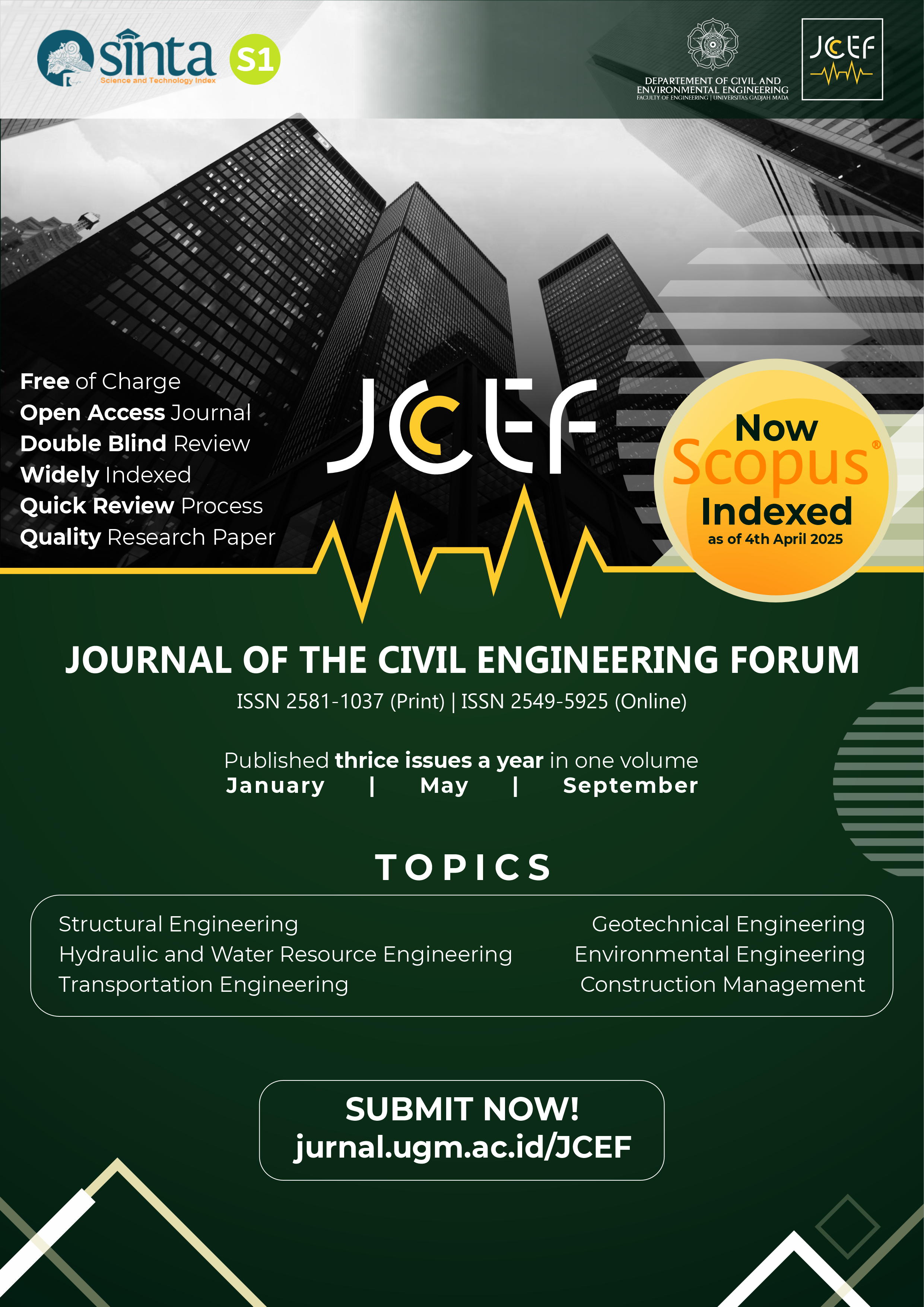Dynamic Properties Comparison of 1D, 2D, and 3D Model for Concrete Box-Girder Bridge of 40-meter Span
Abstract
Concrete box-girder structure is considered the thin-walled structure, undergoing deformation and forces, as well as having structural rigidity in three dimensional directions. However, it’s commonly modeled as 1D structure for the sake of design practicality, which influences the numerical result of its dynamic properties when compared to both real time SHMS and field test result. To see how far the difference of the dynamic properties between 1D, 2D, and 3D model of concrete box-girder structure, the concrete box-girder structure is modeled as 1D (frame), 2D (shell), and 3D (solid) element with MIDAS Civil 2019. Considering the allowable deflection and stress limited by design code, concrete box-girder structure is modeled and analyzed as linearly elastic material. The dynamic properties obtained from these 3 models were compared with those obtained from real time SHMS and field test. These results indicate that both natural frequency and period of 2D and 3D models are close to those of real time SHMS and field test. However, the natural frequency of 1D model is slightly larger than the real SHMS and field test, indicating that 1D model gives the slightly overestimate natural frequency and structural rigidity compared to the reality. Unlike 2D and 3D model, the structure is accounted to have the uniform sectional rigidity along transversal direction in 1D model. This is why 1D model seems to have higher structural rigidity compared to 2D and 3D model, which subsequently yields the higher natural frequency than 2D and 3D model. This research proves that the designers’ discretion is advised if 1D model is used for the sake of design practicality.
References
Aloisio, A., 2021. Aspects of Vibration-Based Methods for the Prestressing Estimate in Concrete Beams with Internal Bonded or Unbonded Tendons. Infrastructures 2021, 6, 83. https://doi.org/10.3390/infrastructures6060083
American Association of State Highway and Transportation Officials, 2017. AASHTO LRFD Bridge Design Specification, Eighth Edition. American Association of State Highway and Transportation Officials 444 North Capitol Street, NW, Suite 249, Washington, DC 20001.
Atmaca, B., 2019. Comparison of Dynamic Characteristics of Prestressed and Reinforced Concrete Beams. Düzce University Journal of Science & Technology, 7 (2019) 37-44.
Bhavikatti, S.S., 2005. Finite Element Analysis. New Age International (P) Ltd., Publishers 4835/24, Ansari Road, Daryaganj, New Delhi – 110002.
Carrera, E., Pagani, A., Zangallo, F., 2015. Comparison of Various 1D, 2D, and 3D FE Model for The Model of Thin-walled box with Transverse Ribs Subjected to Load Factors. Elsevier BV, Finite Element in Analysis and Design 95 (2015) 1-11, https://dx.doi.org/10.1016/j.finel.2014.10.004
Direktorat Jenderal Bina Marga, 2021. Panduan Praktis Perencanaan Teknis Jembatan 02/M/BM/2021. Kementerian Pekerjaan Umum dan Perumahan Rakyat, Jakarta.
Hamed, E., Frostig, Y., 2006. Natural Frequencies of Bonded and Unbonded Prestressed Beams – Prestressed Force Effects. Elsevier Ltd., Journal of Sound and Vibration 295 (2006) 28–39, https://doi.org/10.1016/j.jsv.2005.11.032
Ibrahim, E.S.M., 2004. Comparison Study on The Accuracy of Reinforced Concrete T-Beam Analyzed by Using Plane Stress and Solid Finite Elements. Yogyakarta: Master Thesis Report. Department of Civil and Environmental Engineering. Universitas Gadjah Mada.
Liu, G.R., Quek, S.S., 2003. The Finite Element Method – A practical course. Elsevier Science Ltd. Butterworth-Heinemann, England.
Miyamoto, A., Tei, K., Nakamura, H., Bull, J.W., 2000. Behaviour of Prestressed Beam Strengthened with External Tendons. Journal of Structural Engineering, Vol. 126, No. 9, September, 2000. ASCE, ISSN 0733-9445/00/0009-1033–1044.
Suhendro, B., 1990. Analisis Buckling pada Struktur dengan Finite Element Method. Media Teknik Edisi No. 1 Tahun XII, April 1990, No. ISSN 0216-3012.
Copyright (c) 2022 The Author(s)

This work is licensed under a Creative Commons Attribution-ShareAlike 4.0 International License.
Copyright is granted to authors for the purpose of providing protection for articles written to describe experiments and their results. JCEF will protect and defend the work and reputation of the author and are also willing to address any allegations of violation, plagiarism, fraud, etc. against articles written and published by JCEF. JCEF is published under the terms of the Creative Commons Attribution-ShareAlike 4.0 International License (CC BY-SA 4.0). The author holds the copyright and assigns the journal rights to the first publication (online and print) of the work simultaneously.







